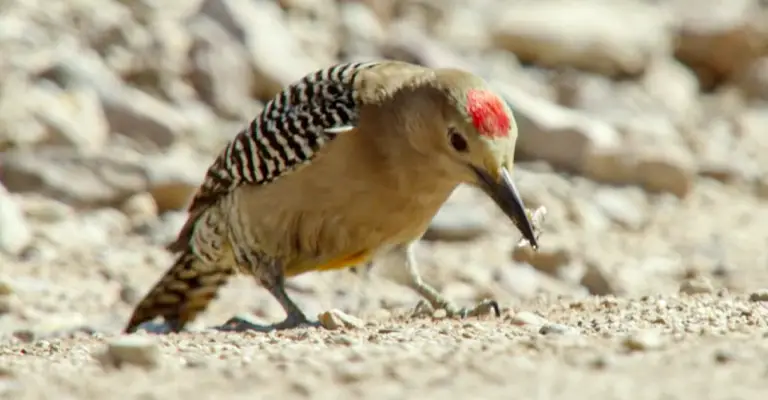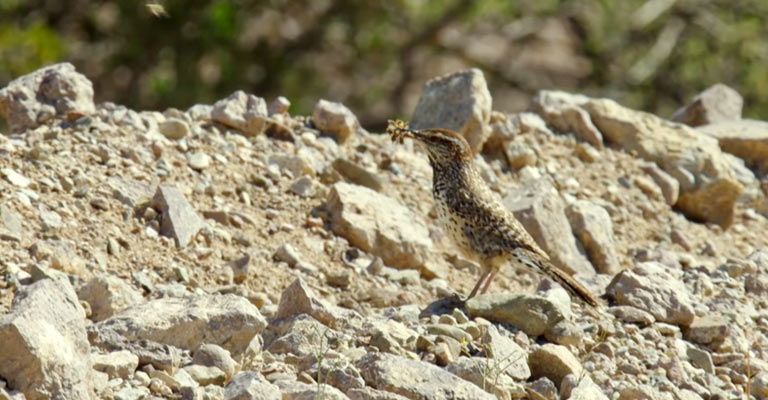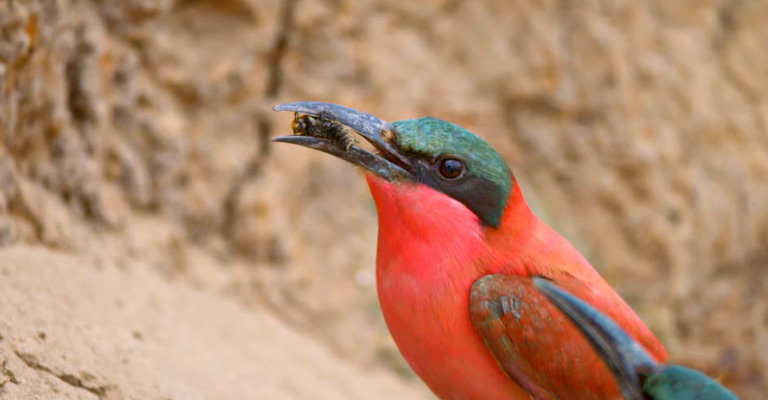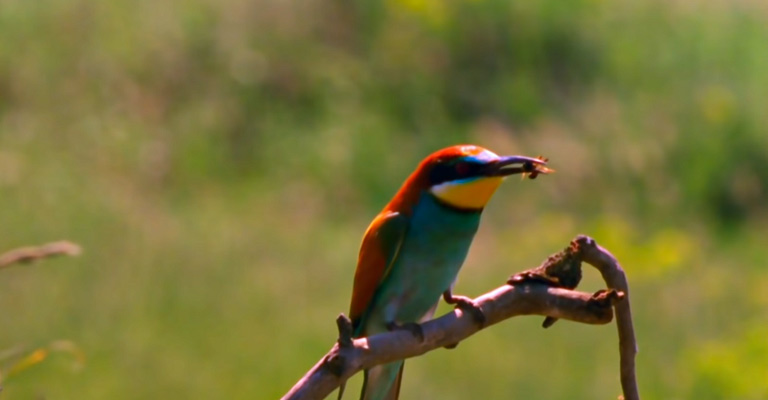Birds, with their diverse diets and foraging behaviors, have always fascinated naturalists and bird enthusiasts alike. Among the myriad of insects and small creatures they consume, bees often find their way onto the avian menu.
However, the question of whether birds play a significant role in bee predation and its implications for bee populations warrants a closer look.
In this blog post, we will explore the facts about birds eating bees. Are they voracious bee hunters or occasional opportunists? How do they manage to dine on these stinging insects without getting stung themselves?
We’ll delve into the bird species known for this peculiar dietary choice and examine the real impact they have on bee populations. By separating fact from fiction, we aim to shed light on the complex interactions between birds and bees in our natural world. So, stay focused.

Do Birds Eat Bees?
Some birds do eat bees. Bee-eaters, a family of colorful birds found in various parts of the world, are known for their insect-heavy diets, which may include bees. They are highly skilled aerial hunters and catch bees and other flying insects in flight.
Bee-eaters have specialized adaptations, such as sharp bills and agile flight, which help them catch and consume bees without getting stung. While bees are not a primary food source for most birds, bee-eaters are a notable exception.
However, it’s essential to note that bee-eaters typically consume the entire bee, including the stinger, which doesn’t harm them due to their specialized digestive systems. So, while not all birds eat bees, bee-eaters have developed unique strategies to make them a part of their diet.
When Do Birds Eat Bees?
Birds, particularly bee-eaters, may eat bees under various circumstances:
Feeding Time
Birds that eat bees, like bee-eaters, primarily consume them during their feeding times.
Daylight Hours
Most birds are diurnal, so they tend to hunt for bees during daylight hours when the insects are active.
Warmer Seasons
Bees are more abundant in warmer seasons, making them a more readily available food source for birds.
Flying Prey
Birds typically catch bees while they are in flight. They use their agility and sharp bills to capture bees on the wing.
Hive Raids
Some birds may raid beehives to consume bees, larvae, and honey. However, this is less common and can result in confrontations with defensive bees.
Solely Insectivorous Birds
Birds that primarily feed on insects, like bee-eaters, are more likely to include bees in their diet.
Specialized Adaptations
Birds that eat bees often have specialized adaptations to handle stings, such as specific hunting techniques or digestive systems that neutralize bee venom.
Varied Diet
While bees may be a part of their diet, birds, including bee-eaters, also consume other insects to meet their nutritional needs.
Birds eat bees primarily during daylight hours, in warmer seasons, when bees are flying. Birds with specialized adaptations and a primarily insectivorous diet, like bee-eaters, are more likely to include bees in their meals.
What Type of Bees Brid Eats?

Birds that eat bees typically consume a variety of bee species, but they may have preferences depending on their geographic location and habitat. The specific types of bees that birds eat can include:
Honey Bees (Apis spp.)
Honey bees are a common target for birds due to their abundance and social nature. Birds may raid beehives to consume honey bees, bee larvae, and honey.
Bumblebees (Bombus spp.)
Bumblebees are another common type of bee that birds may consume, especially when they are in flight.
Solitary Bees
Some birds may prey on solitary bees that are active and flying in their habitats. Solitary bees come in various species and are often smaller than social bees.
Native Bees
Birds may eat native bee species that are found in their particular region. These can vary widely depending on the location.
Carpenter Bees (Xylocopa spp.)
Certain birds, like woodpeckers, may consume carpenter bees that drill into wood to create their nests.
Mason Bees (Osmia spp.)
Birds may also eat mason bees, which are solitary bees that nest in holes and crevices.
It’s essential to note that while some birds include bees in their diet, bees are not the primary food source for most bird species.
Bird Species Known for Eating Bees

Several bird species are known to include bees as part of their diet. Bees provide a protein-rich food source for these birds, especially during the warm months when bees are active. Here are some bird species that are known for eating bees:
Bee-eaters (Meropidae)
Bee-eaters are a family of colorful birds found in Africa, Asia, and parts of Europe. They are named for their diet, which includes various flying insects, including bees and wasps. Bee-eaters are known for their stunning plumage and aerial acrobatics.
Purple Martins (Progne subis)
Purple Martins are North American swallows that primarily feed on flying insects, including bees. They are cavity nesters and are often encouraged to nest in human-made birdhouses to help control insect populations.
Eastern Bluebirds (Sialia sialis)
Eastern Bluebirds are insectivorous birds found in North America. While their primary diet consists of insects like beetles, caterpillars, and grasshoppers, they may also consume bees when they encounter them.
European Rollers (Coracias garrulus)
European Rollers are colorful birds found in parts of Europe and Asia. They are known for their diet, which includes a variety of insects, including bees and wasps.
Swallow-tailed Kites (Elanoides forficatus)
Swallow-tailed Kites are elegant raptors found in the Americas. They are known for their graceful flight and diet, which includes flying insects, including bees and wasps.
Greater Honeyguide (Indicator indicator)
This African bird species is known for its unique relationship with honey hunters. It guides humans and other animals to beehives, and after the honey is harvested, it feeds on the remaining beeswax and larvae.
Beehawks (Perninae)
Beehawks are a subfamily of birds within the honeyeater family found in Australia. They are known for their diet, which includes nectar from flowers as well as insects, including bees.
It’s important to note that while these bird species do eat bees, they usually do not rely solely on bees as their primary food source. Instead, bees are just one part of their varied diets.
Additionally, many bird species have evolved various strategies to capture and consume stinging insects like bees without getting stung, such as removing the stingers before eating.
The Impact on Bee Populations

Birds that feed on bees can have localized impacts on bee populations, but these impacts are generally not a major factor in the overall decline of bee populations worldwide. Here are some points to consider regarding the impact of bee-eating birds on bee populations:
Localized Effects
Birds that feed on bees, such as bee-eaters and certain species of swallows, may have localized effects on bee populations in specific areas where they are abundant. In such areas, the bird predation could reduce the numbers of certain bee species.
Natural Predation
Predation by birds is a part of the natural ecosystem, and many bee species have evolved mechanisms to defend themselves against bird predation. For example, some bees are fast and agile in flight, making them difficult targets for birds.
Balancing Role
In some cases, bird predation on bees can help maintain a balance within ecosystems. Excessive bee populations can lead to over-pollination of certain plants, which can have ecological consequences. Birds that feed on bees may help regulate bee populations in a given area.
Limited Impact on Decline
The main factors contributing to the decline in bee populations are habitat loss, pesticide use, disease, and climate change. While predation by birds may play a small role in bee mortality, it is not a primary driver of bee population declines on a global scale.
Varied Diet
Birds that eat bees typically have diverse diets that include various other insects, so their reliance on bees alone is limited. They may switch to other prey when bee populations are low.
Human Activity
Human activities, such as habitat destruction, pesticide use, and the spread of invasive species, have more substantial and widespread impacts on bee populations than predation by birds.
Misconceptions and Myths Regarding Birds Eating Bees
There are several misconceptions and myths regarding birds eating bees. It’s essential to clarify these misconceptions to better understand the ecological dynamics and the role of birds in bee populations. Here are some common misconceptions:
Birds are The Primary Cause of Bee Population Decline
This is a significant misconception. While some bird species do eat bees, they are not the primary cause of bee population declines. Factors such as habitat loss, pesticide use, disease, and climate change are far more significant contributors to bee declines.
Birds Kill Bees Indiscriminately
Many birds that feed on bees have evolved specialized techniques to capture and consume bees without getting stung. They may remove the stingers or target specific parts of the bee that are not equipped with stingers, such as the thorax. Birds are not necessarily killing bees in large numbers.
Birds Exclusively Feed on Bees
Birds that eat bees typically have diverse diets that include various other insects, nectar, fruits, and even small vertebrates. Bees are just one component of their diet, and they do not rely solely on bees for sustenance.
Bird Predation is a Major Factor in Bee Population Fluctuations
While birds can have localized effects on bee populations, these effects are usually minor in the context of broader ecological dynamics. Bee populations are more strongly influenced by factors such as food availability, habitat quality, and environmental stressors.
Birds are Responsible for Pollinating Bees
This is not accurate. Birds are not pollinators of bees. Bees are primarily pollinated by other bees or insects. Birds have different foraging behaviors and do not contribute significantly to the pollination of bee-pollinated plants.
Birds are Harmful to Beekeeping
Beekeepers often work to protect their hives from various threats, including pests, diseases, and predators. While some birds might occasionally consume bees near beehives, they are not the primary threat to beekeeping operations.
While certain bird species do consume bees, it is crucial to recognize that bird predation on bees is a relatively minor aspect of the complex interactions within ecosystems. The main threats to bee populations are human-induced factors, and addressing these issues is essential for bee conservation and ecosystem health.
FAQs
Yes, some bird species do eat bees as part of their diet. However, bee predation is just one component of their varied food sources, and birds have evolved strategies to minimize the risk of getting stung when consuming bees.
Bird species known for eating bees include bee-eaters, swallows, purple martins, European rollers, and certain honeyeaters. These birds have adapted to capture and consume bees as part of their insect-rich diets.
No, bird predation on bees typically has localized and minor effects on bee populations. The primary threats to bees are human-induced factors like habitat loss, pesticide use, disease, and climate change, which have more substantial and widespread impacts.
No, birds are not pollinators of bees. Bees primarily pollinate through their foraging and interactions with flowers. Birds have different feeding behaviors and do not play a significant role in the pollination of bee-pollinated plants.
Birds that eat bees have developed specialized techniques. They may remove the stingers before consuming them, target non-stinging body parts, or have evolved behaviors to minimize the risk of getting stung. These adaptations allow them to include bees in their diets while avoiding injury.
Wrapping Up
While it’s true that some bird species do include bees in their diet, it’s crucial to recognize that bird predation on bees is a small piece of a much larger ecological puzzle.
The primary threats to bee populations lie elsewhere, including habitat loss, pesticide use, disease, and climate change. Birds’ foraging habits have evolved over millennia, and they’ve found ways to minimize the risk of stings while consuming bees.
In the grand scheme of things, birds and bees coexist within ecosystems, each playing their distinct roles. These interactions help us appreciate the intricate balance of nature and underscore the importance of addressing the pressing issues threatening bee populations.